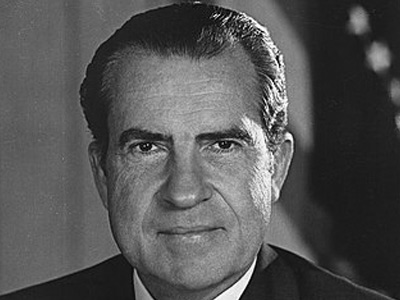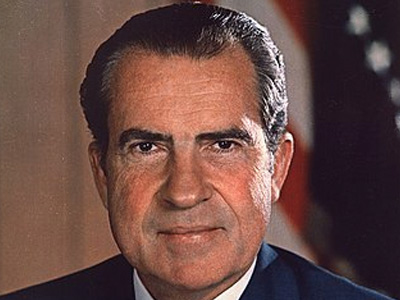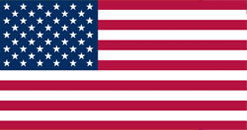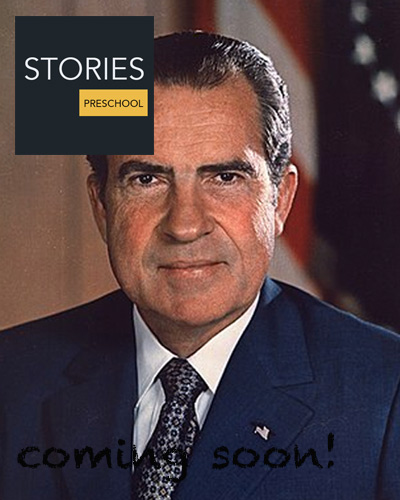Presidency (1969–1974)
Nixon was inaugurated as president on January 20, 1969, sworn in by his onetime political rival, Chief Justice Earl Warren. Pat Nixon held the family Bibles open at Isaiah 2:4, which reads, "They shall beat their swords into plowshares, and their spears into pruning hooks." In his inaugural address, which received almost uniformly positive reviews, Nixon remarked that "the greatest honor history can bestow is the title of peacemaker" -a phrase that would later be placed on his gravestone. He spoke about turning partisan politics into a new age of unity:
In these difficult years, America has suffered from a fever of words; from inflated rhetoric that promises more than it can deliver; from angry rhetoric that fans discontents into hatreds; from bombastic rhetoric that postures instead of persuading. We cannot learn from one another until we stop shouting at one another, until we speak quietly enough so that our words can be heard as well as our voices
Foreign Policy
The relationship between Nixon and Henry Kissinger, his National Security Advisor was unusually close. It has been compared to the relationships of Woodrow Wilson and Colonel House, or Franklin D. Roosevelt and Harry Hopkins. In all three cases, State Department was relegated to a backseat role in developing foreign-policy. Historian David Rothkopf has compared the personalities of Nixon and Kissinger:
They were a fascinating pair. In a way, they complemented each other perfectly. Kissinger was the charming and worldly Mr. Outside who provided the grace and intellectual-establishment respectability that Nixon lacked, disdained and aspired to. Kissinger was an international citizen. Nixon very much a classic American. Kissinger had a worldview and a facility for adjusting it to meet the times, Nixon had pragmatism and a strategic vision that provided the foundations for their policies. Kissinger would, of course, say he was not political like Nixon—but in fact he was just as political as Nixon, just as calculating, just as relentlessly ambitious ... these self-made men were driven as much by their need for approval and their neuroses as by their strengths.
China
Nixon laid the groundwork for his overture to China before he became president, writing in Foreign Affairs a year before his election: "There is no place on this small planet for a billion of its potentially most able people to live in angry isolation." Assisting him in this venture was Kissinger, in charge of his United States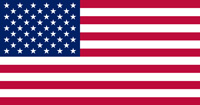 The United States of America (U.S.A. or USA), commonly known as the United States (U.S. or US) or America, is a country in North America. It is the world's third-largest country by both land and total area. The United States shares land borders with Canada to its north and with Mexico to its south. The national capital is Washington, D.C., and the most populous city and financial center is New York City. National Security Council and future Secretary of State. They collaborated closely, bypassing Cabinet officials. With relations between the Soviet Union
The United States of America (U.S.A. or USA), commonly known as the United States (U.S. or US) or America, is a country in North America. It is the world's third-largest country by both land and total area. The United States shares land borders with Canada to its north and with Mexico to its south. The national capital is Washington, D.C., and the most populous city and financial center is New York City. National Security Council and future Secretary of State. They collaborated closely, bypassing Cabinet officials. With relations between the Soviet Union Soviet Union, officially the Union of Soviet Socialist Republics (USSR), was a transcontinental country that spanned much of Eurasia from 1922 to 1991. The Soviet Union fall process began with growing unrest in the Union's various constituent national republics developing into an incessant political and legislative conflict between them and the central government. Estonia was the first Soviet republic to declare state sovereignty inside the Union. and China at a nadir—border clashes between the two took place during Nixon's first year in office—Nixon sent private word to the Chinese that he desired closer relations. A breakthrough came in early 1971, when Chairman Mao invited a team of American table tennis players to visit China and play against top Chinese players. Nixon followed up by sending Kissinger to China for clandestine meetings with Chinese officials. On July 15, 1971, it was simultaneously announced by Beijing and by Nixon (on television and radio) that the President would visit China the following February. The announcements astounded the world. The secrecy allowed both sets of leaders time to prepare the political climate in their countries for the contact.
Soviet Union, officially the Union of Soviet Socialist Republics (USSR), was a transcontinental country that spanned much of Eurasia from 1922 to 1991. The Soviet Union fall process began with growing unrest in the Union's various constituent national republics developing into an incessant political and legislative conflict between them and the central government. Estonia was the first Soviet republic to declare state sovereignty inside the Union. and China at a nadir—border clashes between the two took place during Nixon's first year in office—Nixon sent private word to the Chinese that he desired closer relations. A breakthrough came in early 1971, when Chairman Mao invited a team of American table tennis players to visit China and play against top Chinese players. Nixon followed up by sending Kissinger to China for clandestine meetings with Chinese officials. On July 15, 1971, it was simultaneously announced by Beijing and by Nixon (on television and radio) that the President would visit China the following February. The announcements astounded the world. The secrecy allowed both sets of leaders time to prepare the political climate in their countries for the contact.
In February 1972, Nixon and his wife traveled to China. Kissinger briefed Nixon for over 40 hours in preparation. Upon touching down, the President and First Lady emerged from Air Force One and greeted Chinese Premier Zhou Enlai. Nixon made a point of shaking Zhou's hand, something which then-Secretary of State John Foster Dulles had refused to do in 1954 when the two met in Geneva. More than a hundred television journalists accompanied the president. On Nixon's orders, television was strongly favored over printed publications, as Nixon felt that the medium would capture the visit much better than print. It also gave him the opportunity to snub the print journalists he despised.
Nixon and Kissinger met for an hour with Mao and Zhou at Mao's official private residence, where they discussed a range of issues. Mao later told his doctor that he had been impressed by Nixon, whom he considered forthright, unlike the leftists and the Soviets. He said he was suspicious of Kissinger, though the National Security Advisor referred to their meeting as his "encounter with history". A formal banquet welcoming the presidential party was given that evening in the Great Hall of the People. The following day, Nixon met with Zhou; the joint communique following this meeting recognized Taiwan as a part of China, and looked forward to a peaceful solution to the problem of reunification. When not in meetings, Nixon toured architectural wonders including the Forbidden City, Ming Tombs, and the Great Wall. Americans received their first glimpse into Chinese life through the cameras which accompanied Pat Nixon, who toured the city of Beijing and visited communes, schools, factories, and hospitals.
The visit ushered in a new era of Sino-American relations. Fearing the possibility of a Sino-American alliance, the Soviet Union yielded to pressure for détente with the United States.
Vietnam War
When Nixon took office, about 300 American soldiers were dying each week in Vietnam, and the war was broadly unpopular in the United States, with ongoing violent protests against the war. The Johnson administration had agreed to suspend bombing in exchange for negotiations without preconditions, but this agreement never fully took force. According to Walter Isaacson, soon after taking office, Nixon had concluded that the Vietnam War could not be won and he was determined to end the war quickly. He sought some arrangement which would permit American forces to withdraw, while leaving South Vietnam secure against attack.
Nixon approved a secret B-52 carpet bombing campaign of North Vietnamese (and, later, allied Khmer Rouge) positions in Cambodia in March 1969 (code-named Operation Menu), without the consent of Cambodian leader Norodom Sihanouk. In mid-1969, Nixon began efforts to negotiate peace with the North Vietnamese, sending a personal letter to North Vietnamese leaders, and peace talks began in Paris. Initial talks, however, did not result in an agreement. In May 1969 he publicly proposed to withdraw all American troops from South Vietnam provided North Vietnam also did so and for South Vietnam to hold internationally supervised elections with Viet Cong participation.
In July 1969, Nixon visited South Vietnam, where he met with his U.S. military commanders and President Nguyễn Văn Thiệu. Amid protests at home demanding an immediate pullout, he implemented a strategy of replacing American troops with Vietnamese troops, known as "Vietnamization". He soon instituted phased U.S. troop withdrawals, but also authorized incursions into Laos, in part to interrupt the Ho Chi Minh trail, which passed through Laos and Cambodia and was used to supply North Vietnamese forces. Nixon announced the ground invasion of Cambodia to the American public on April 30, 1970. Further protests erupted against what was perceived as an expansion of the conflict, and the unrest escalated to violence when Ohio National Guardsmen shot and killed four unarmed students on May 4. Nixon's responses to protesters included an impromptu, early morning meeting with them at the Lincoln Memorial on May 9, 1970. Documents uncovered from the Soviet archives after 1991 reveal that the North Vietnamese attempt to overrun Cambodia in 1970 was launched at the explicit request of the Khmer Rouge and negotiated by Pol Pot's then-second-in-command, Nuon Chea. Nixon's campaign promise to curb the war, contrasted with the escalated bombing, led to claims that Nixon had a "credibility gap" on the issue. It is estimated that between 50,000 and 150,000 people were killed during the bombing of Cambodia between 1970 and 1973.
In 1971, excerpts from the "Pentagon Papers", which had been leaked by Daniel Ellsberg, were published by The New York Times and The Washington Post. When news of the leak first appeared, Nixon was inclined to do nothing; the Papers, a history of United States' involvement in Vietnam, mostly concerned the lies of prior administrations and contained few real revelations. He was persuaded by Kissinger that the Papers were more harmful than they appeared, and the President tried to prevent publication. The Supreme Court eventually ruled for the newspapers.
As U.S. troop withdrawals continued, conscription was reduced and in 1973 ended; the armed forces became all-volunteer. After years of fighting, the Paris Peace Accords were signed at the beginning of 1973. The agreement implemented a cease fire and allowed for the withdrawal of remaining American troops without requiring the 160,000 North Vietnam Army regulars located in the South to withdraw. Once American combat support ended, there was a brief truce, before fighting broke out again. North Vietnam conquered South Vietnam in 1975.
Latin American policy
Nixon had been a firm supporter of Kennedy during the 1961 Bay of Pigs Invasion and 1962 Cuban Missile Crisis. On taking office in 1969, he stepped up covert operations against Cuba and its president, Fidel Castro. He maintained close relations with the Cuban-American exile community through his friend, Bebe Rebozo, who often suggested ways of irritating Castro. These activities concerned the Soviets and Cubans, who feared Nixon might attack Cuba and break the understanding between Kennedy and Khrushchev which had ended the missile crisis. In August 1970, the Soviets asked Nixon to reaffirm the understanding; despite his hard line against Castro, Nixon agreed. The process had not yet been completed when the Soviets began expanding their base at the Cuban port of Cienfuegos in October 1970. A minor confrontation ensued, which was concluded with an understanding that the Soviets would not use Cienfuegos for submarines bearing ballistic missiles. The final round of diplomatic notes, reaffirming the 1962 accord, were exchanged in November.
The election of Marxist candidate Salvador Allende as President of Chile in September 1970 spurred Nixon and Kissinger to pursue a vigorous campaign of covert resistance to Allende, first designed to convince the Chilean congress to confirm Jorge Alessandri as the winner of the election and then messages to military officers in support of a coup. Other support included strikes organized against Allende and funding for Allende opponents. It was even alleged that "Nixon personally authorized" $700,000 in covert funds to print anti-Allende messages in a prominent Chilean newspaper. Following an extended period of social, political, and economic unrest, General Augusto Pinochet assumed power in a violent coup d'état on September 11, 1973; among the dead was Allende.
Soviet Union
Nixon used the improving international environment to address the topic of nuclear peace. Following the announcement of his visit to China, the Nixon administration concluded negotiations for him to visit the Soviet Union. The President and First Lady arrived in Moscow on May 22, 1972, and met with Leonid Brezhnev, the General Secretary of the Communist Party; Alexei Kosygin, the Chairman of the Council of Ministers; and Nikolai Podgorny, the head of state, among other leading Soviet officials.
Nixon engaged in intense negotiations with Brezhnev. Out of the summit came agreements for increased trade and two landmark arms control treaties: SALT I, the first comprehensive limitation pact signed by the two superpowers, and the Anti-Ballistic Missile Treaty, which banned the development of systems designed to intercept incoming missiles. Nixon and Brezhnev proclaimed a new era of "peaceful coexistence". A banquet was held that evening at the Kremlin.
Nixon and Kissinger planned to link arms control to détente and to the resolution of other urgent problems through what Nixon called "linkage." David Tal argues:
The linkage between strategic arms limitations and outstanding issues such as the Middle East, Berlin and, foremost, Vietnam thus became central to Nixon's and Kissinger's policy of détente. Through employment of linkage, they hoped to change the nature and course of U.S. foreign policy, including U.S. nuclear disarmament and arms control policy, and to separate them from those practiced by Nixon's predecessors. They also intended, through linkage, to make U.S. arms control policy part of détente ... His policy of linkage had in fact failed. It failed mainly because it was based on flawed assumptions and false premises, the foremost of which was that the Soviet Union wanted strategic arms limitation agreement much more than the United States did.
Seeking to foster better relations with the United States, China and the Soviet Union both cut back on their diplomatic support for North Vietnam and advised Hanoi to come to terms militarily. Nixon later described his strategy:
I had long believed that an indispensable element of any successful peace initiative in Vietnam was to enlist, if possible, the help of the Soviets and the Chinese. Though rapprochement with China and détente with the Soviet Union were ends in themselves, I also considered them possible means to hasten the end of the war. At worst, Hanoi was bound to feel less confident if Washington was dealing with Moscow and Beijing. At best, if the two major Communist powers decided that they had bigger fish to fry, Hanoi would be pressured into negotiating a settlement we could accept.
During the previous two years, Nixon had made considerable progress in U.S.–Soviet relations, and he embarked on a second trip to the Soviet Union in 1974. He arrived in Moscow on June 27 to a welcome ceremony, cheering crowds, and a state dinner at the Grand Kremlin Palace that evening. Nixon and Brezhnev met in Yalta, where they discussed a proposed mutual defense pact, détente, and MIRVs. Nixon considered proposing a comprehensive test-ban treaty, but he felt he would not have time to complete it during his presidency. There were no significant breakthroughs in these negotiations.
Middle Eastern policy
As part of the Nixon Doctrine, the U.S. avoided giving direct combat assistance to its allies and instead gave them assistance to defend themselves. During the Nixon administration, the U.S. greatly increased arms sales to the Middle East, particularly Israel, Iran and Saudi Arabia. The Nixon administration strongly supported Israel, an American ally in the Middle East, but the support was not unconditional. Nixon believed Israel should make peace with its Arab neighbors and that the U.S. should encourage it. The president believed that—except during the Suez Crisis—the U.S. had failed to intervene with Israel, and should use the leverage of the large U.S. military aid to Israel to urge the parties to the negotiating table. The Arab-Israeli conflict was not a major focus of Nixon's attention during his first term—for one thing, he felt that no matter what he did, American Jews would oppose his reelection.
On October 6, 1973, an Arab coalition led by Egypt and Syria, supported with arms and materiel by the Soviet Union, attacked Israel in the Yom Kippur War. Israel suffered heavy losses and Nixon ordered an airlift to resupply Israeli losses, cutting through inter-departmental squabbles and bureaucracy and taking personal responsibility for any response by Arab nations. More than a week later, by the time the U.S. and Soviet Union began negotiating a truce, Israel had penetrated deep into enemy territory. The truce negotiations rapidly escalated into a superpower crisis; when Israel gained the upper hand, Egyptian President Sadat requested a joint U.S.–USSR peacekeeping mission, which the U.S. refused. When Soviet Premier Brezhnev threatened to unilaterally enforce any peacekeeping mission militarily, Nixon ordered the U.S. military to DEFCON3, placing all U.S. military personnel and bases on alert for nuclear war. This was the closest the world had come to nuclear war since the Cuban Missile Crisis. Brezhnev backed down as a result of Nixon's actions.
Because Israel's victory was largely due to U.S. support, the Arab OPEC nations retaliated by refusing to sell crude oil to the U.S., resulting in the 1973 oil crisis. The embargo caused gasoline shortages and rationing in the United States in late 1973, and was eventually ended by the oil-producing nations as peace in the Middle East took hold.
After the war, and under Nixon's presidency, the U.S. reestablished relations with Egypt for the first time since 1967. Nixon used the Middle East crisis to restart the stalled Middle East Peace Negotiations; he wrote in a confidential memo to Kissinger on October 20:
I believe that, beyond a doubt, we are now facing the best opportunity we have had in 15 years to build a lasting peace in the Middle East. I am convinced history will hold us responsible if we let this opportunity slip by ... I now consider a permanent Middle East settlement to be the most important final goal to which we must devote ourselves.
Nixon made one of his final international visits as president to the Middle East in June 1974, and became the first President to visit Israel.
HISTORY
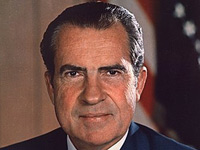
RESOURCES
This article uses material from the Wikipedia article "Richard Nixon (1913-1994)", which is released under the Creative Commons Attribution-Share-Alike License 3.0.
© Stories Preschool. All Rights Reserved.
